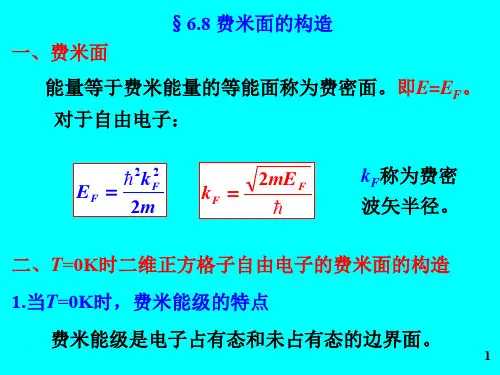费米面ppt课件
- 格式:ppt
- 大小:5.95 MB
- 文档页数:68
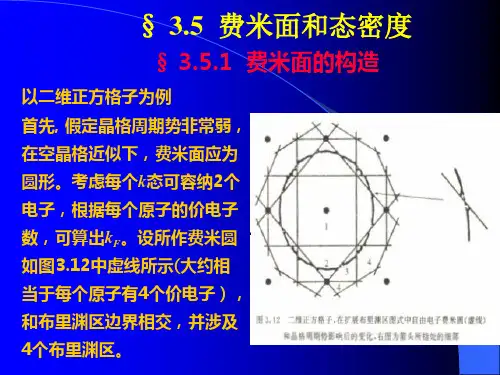
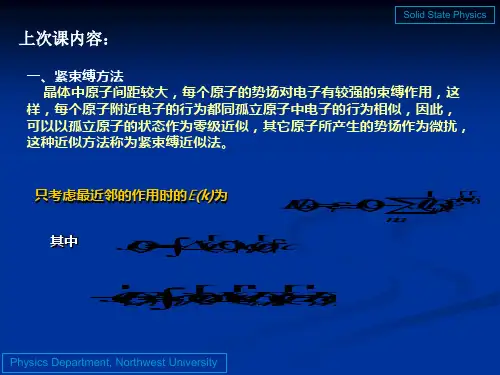

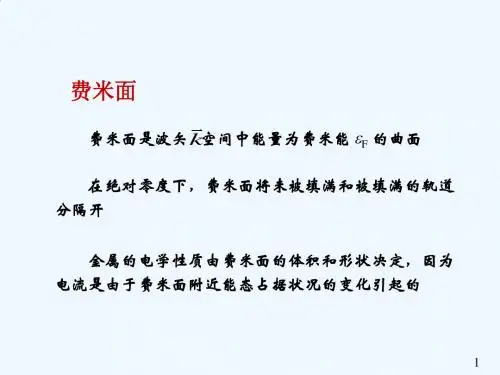
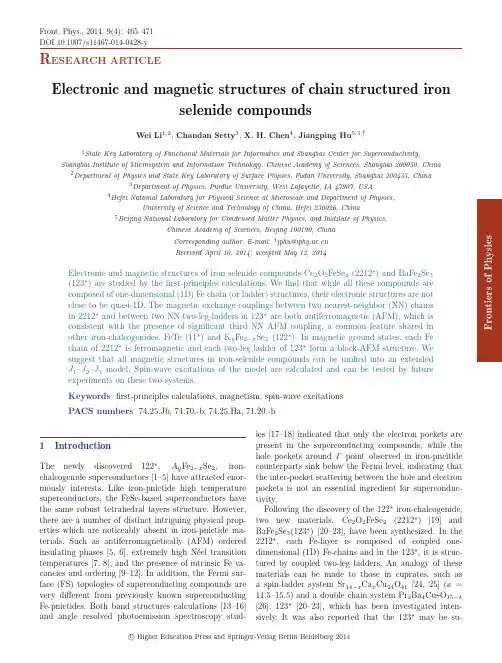
Front.Phys.,2014,9(4):465–471DOI 10.1007/s11467-014-0428-yR ESEARCHARTICLEElectronic and magnetic structures of chain structured ironselenide compoundsWei Li 1,2,Chandan Setty 3,X.H.Chen 4,Jiangping Hu 5,3,†1StateKey Laboratory of Functional Materials for Informatics and Shanghai Center for Superconductivity,Shanghai Institute of Microsystem and Information Technology,Chinese Academy of Sciences,Shanghai 200050,China2Departmentof Physics and State Key Laboratory of Surface Physics,Fudan University,Shanghai 200433,China3Departmentof Physics,Purdue University,West Lafayette,IA 47907,USA4HefeiNational Laboratory for Physical Science at Microscale and Department of Physics,University of Science and Technology of China,Hefei 230026,China5BeijingNational Laboratory for Condensed Matter Physics,and Institute of Physics,Chinese Academy of Sciences,Beijing 100190,China Corresponding author.E-mail:†jphu@ Received April 10,2014;accepted May 12,2014Electronic and magnetic structures of iron selenide compounds Ce 2O 2FeSe 2(2212∗)and BaFe 2Se 3(123∗)are studied by the first-principles calculations.We find that while all these compounds are composed of one-dimensional (1D)Fe chain (or ladder)structures,their electronic structures are not close to be quasi-1D.The magnetic exchange couplings between two nearest-neighbor (NN)chains in 2212∗and between two NN two-leg-ladders in 123∗are both antiferromagnetic (AFM),which is consistent with the presence of significant third NN AFM coupling,a common feature shared in other iron-chalcogenides,FeTe (11∗)and K y Fe 2−x Se 2(122∗).In magnetic ground states,each Fe chain of 2212∗is ferromagnetic and each two-leg ladder of 123∗form a block-AFM structure.We suggest that all magnetic structures in iron-selenide compounds can be unified into an extended J 1–J 2–J 3model.Spin-wave excitations of the model are calculated and can be tested by future experiments on these two systems.Keywords first-principles calculations,magnetism,spin-wave excitations PACS numbers 74.25.Jb,74.70.-b,74.25.Ha,71.20.-b1IntroductionThe newly discovered 122∗,A y Fe 2−x Se 2,iron-chalcogenide superconductors [1–5]have attracted enor-mously interests.Like iron-pnictide high temperature superconductors,the FeSe-based superconductors have the same robust tetrahedral layers structure.However,there are a number of distinct intriguing physical prop-erties which are noticeably absent in iron-pnictide ma-terials.Such as antiferromagnetically (AFM)ordered insulating phases [5,6],extremely high N´e el transition temperatures [7,8],and the presence of intrinsic Fe va-cancies and ordering [9–12].In addition,the Fermi sur-face (FS)topologies of superconducting compounds are very different from previously known superconducting Fe-pnictides.Both band structures calculations [13–16]and angle resolved photoemission spectroscopy stud-ies [17–18]indicated that only the electron pockets are present in the superconducting compounds,while the hole pockets around Γpoint observed in iron-pncitide counterparts sink below the Fermi level,indicating that the inter-pocket scattering between the hole and electron pockets is not an essential ingredient for superconduc-tivity.Following the discovery of the 122∗iron-chalcogenide,two new materials,Ce 2O 2FeSe 2(2212∗)[19]and BaFe 2Se 3(123∗)[20–23],have been synthesized.In the 2212∗,each Fe-layer is composed of coupled one-dimensional (1D)Fe-chains and in the 123∗,it is struc-tured by coupled two-leg ladders.An analogy of these materials can be made to those in cuprates,such as a spin-ladder system Sr 14−x Ca x Cu 24O 41[24,25](x =11.5–15.5)and a double chain system Pr 2Ba 4Cu 7O 15−δ[26].123∗[20–23],which has been investigated inten-sively.It was also reported that the 123∗may be su-R ESEARCH ARTICLE perconducting[20].In this paper,we present the theoretical study of theelectronic band structures and magnetic orders in theseiron selenide systems featured with low-dimensional ironstructures.We investigate two materials including2212∗and123∗and show that while all these compounds arecomposed of1D Fe chain structures,their electronic structures are not close to be quasi-1D.Their FS still ex-hibit two dimensional or even three dimensional topolo-gies.We calculate their magnetic ordered ground states. In2212∗,the magnetic order ground state is a collinear-AFM(CAF),similar to iron-pncitides.In123∗,the magnetic structure is a block-AFM(BAF),similar to KFe2Se2[27].The magnetic exchange couplings between two nearest neighbor(NN)chains in2212∗and between two NN two-leg-ladders in123∗are both AFM,which is consistent with the presence of significant third NN AFM coupling,J3,in FeTe(11∗)and122∗.This result suggests that all magnetic structures in iron selenide compounds can be unified into an extended J1–J2–J3model.We also calculate spin-wave excitations of the model which can be tested in future experiments on these two systems. 2Theories and results2.1First-principles calculationsWe perform thefirst-principles calculations on the iron selenide compounds:2212∗,which has1D chains of edge-shared FeSe4tetrahedra structure and123∗,which con-sists double chains(two-legged ladders)of edge-shared FeSe4tetrahedra structure.The crystal structures are shown in Fig.1.In our calculations the projected aug-mented wave method[28]as implemented in the VASP code[29],and the Perdew–Burke–Ernzerhof exchange correlation potential[30]was used.All atomic positions and the lattice constants are allowed to relax simulta-neously to minimize the energy only for nonmagnetic (NM)state.The experimental crystal structures[19,21] are used for calculating magnetic states.A500eV cut-offin the plane wave expansion ensures the calculations converge to10−5eV,and all atomic positions and the lattice constants were optimized until the largest force on any atom was0.005eV/˚A.To properly describe the strong electron correlation in the4f rare earth element Ce,the LDA plus on-site repulsion U method(LDA+U) was employed with the effective U value(U eff=U−J) of12.0eV for the compound2212∗,where the U eff value has been reported in the previous work[31]of CeOFeAs. The results are also checked for consistency with varying U eff values.We do not apply U eff to the itinerant Fe-3dstates.Fig.1Calculated crystal structures of the iron selenide com-pounds:(a)2212∗,which consists of one chain of FeSe4tetrahe-dra structure,and(b)123∗,which consists of two-leg-ladders of edge-sharing FeSe4tetrahedra structure,respectively.First,we focus on the electronic structures of the iron selenide compounds and their dependence on the struc-tural factors.For this purpose,full structural optimiza-tion of the these compounds were performed both over the lattice parameters and the atomic positions includ-ing the internal coordinate z of Se atom by the energy minimization.All these results(not included the inter-nal coordinate)are summarized in the Table1.Actually, both iron selenide compounds of the lattice parameters optimized in our NM calculations are found smaller by about2%than the ones in experimental values[19–22]. In addition,the density of states N(E F)at the Fermi energy are also calculated,and the corresponding elec-tronic specific heat coefficientγ0and Pauli susceptibility χ0are all listed in Table1.Table1Structural parameters,density of states at the Fermi level N(E F)(in the(eV)−1units per Fe atom)and the calculated specific heat coefficientγ0[mJ/(K2·mol)],and Pauli susceptibility χ0(10−9m3/mol)for iron selenide compounds in NM state.Thelattice parameters and the internal coordinates are all optimized within energy minimization.a/˚A b/˚A c/˚A N(E F)γ0χ0 2212∗ 5.5508 5.679416.2566 6.729331.7196 5.4546 123∗ 5.38219.112311.20960.7650 3.60600.6201 Figure2shows the NM state band structure and FS of both iron selenide compounds.As we can see that there are three bands crossing the Fermi level for both iron selenide compounds.Although both iron selenide compounds are composed of1D Fe chain(ladder)struc-tures and exhibit quasi-1D characters,their FSs still ex-hibit two-dimensional or even three dimensional complex topologies.Their NM state electronic structures are very distinct from that of the iron selenide superconductor KFe2Se2[14–17].Therefore,if superconductivity exists in these compounds,it provides a new playground to test theoretical mechanisms.Because the NM state is strongly unstable againstR ESEARCHARTICLEFig.2Electronic structures of the iron selenide compounds in the NM state:The band structure of 2212∗(a),123∗(b),and the corresponding FS (c)and (d),respectively.The Fermi energy is set to zero.moment formation,we turn to study the magnetic struc-tures in both iron selenide compounds.The six different possible magnetic configurations,as shown in Fig.3[fer-romagnetic (FM)state has not been included]are all calculated.In Table 2,we list the energies of different magnetic states.For 2212∗,it is shown that the CAF is the lowest energy state.In the CAF state of 2212∗,spins are FM for each Fe-chains and are AFM between two NN chains.The calculated magnetic moment around each Fe ion is found to be about 3.12μB ,which is well consistence with experimental results 3.33μB at low temperature 12K [19].Furthermore,the calculated band structure of CAF state is shown that 2212∗is a semiconductor with an energy band gap of around 0.64eV,as shown in Fig.4(a),which is also well consistence with reported experi-mental results [19].For 123∗,the BAF state is the lowest energy state.In the BAF state of 123∗,for each two-leg ladder,four spins group together become a superunit.Spins between two NN units are AFM.The coupling be-tween two NN two-leg ladders is also AFM.The moment around each Fe is about 2.85μB for 123∗,and the elec-tronic band structure calculated shows a semiconductor with an energy band gap E g =0.24eV,as shown in Fig.4(b).The very small energy difference between FM state and CAF state is indicative of weak AFM coupling be-tween different chains,and the energy difference between AFM state and CAF state is indicative of strong FM coupling along the chain direction in 2212∗.Similarly,in 123∗system,the small energy difference betweenFMFig.3Schematic top view of five possible magnetic orders in the Fe-Fe square layer of the iron selenide compounds:(a)AFM N´e el order in which the nearest neighboring Fe moments are AFM ordered;(b)Bicollinear-AFM (BCAF)order (the chain direction is changed into vertical direction for 2212∗);(c)CAF order in which the Fe moments are FM ordered along the chain direction and AFM ordered across the chains direction;(d)BAF consisting of FM Fe 4plaquettes tiled AFM along the chain direction;(e)Staggered-BAF (SBAF)configuration with FM diagonal double stripes that are also tiled AFM.R ESEARCH ARTICLETable2Energetic and magnetic properties of the2212∗and 123∗.Results in the magnetic states configurations,as shown in Fig.3using experimental crystal structures[19,21].ΔE is the total energy difference per iron atom in reference to the FM state, and m Fe is the local magnetic moment on Fe.2212∗123∗ΔE(eV)/m Fe(μB)ΔE(eV)/m Fe(μB)FM0/3.130/2.58AFM0.2184/3.11–0.1131/2.38CAF–0.0118/3.12–0.1560/2.77BCAF0.0944/3.13–0.0139/2.55BAF−–0.1615/2.85SBAF−–0.1514/2.74state and BCAF state is also indicative of weak AFM coupling between different ladders,and the energy dif-ference between BAF state and BCAF state indicative of four Fe atom plackets along theladders.Fig.4(a)Electronic band structure of the CAF state in2212∗with an energy band gap E g=0.64eV;(b)Electronic band struc-ture of the BAF state in123∗with an energy band gap E g=0.24 eV.The Fermi energy is set to zero.Nevertheless,these results are consistent with mag-netic exchange couplings obtained in other iron-chalcogenides FeTe and K0.8Fe1.6Se2,where an FM NN coupling J1,an AFM next nearest neighbor(NNN)cou-pling J2,and an third NN AFM J3are necessary in de-scribing magnetic orders.As we will show in next sub-section,the magnetic orders of both materials can be obtained within models with the similar exchange cou-pling parameters.The AFM couplings between two NN chains in the2212∗and between two NN two-leg ladders in the123∗are exactly the third NN AF coupling,J3. The BAF order within each two-leg ladder can also be naturally understood from these couplings.Therefore, overall,the magnetism of all iron-chalcogenides can be unified into an effective model that includes local mag-netic exchange couplings as suggested in32and33.The values of exchange couplings can not be accurately de-termined since the result depends on the selection of the magnetic configurations[27].2.2Magnetic model for Ce2O2FeSe2Following above results and effective models derived for other iron-chalcogenides,we construct the following model to describe this materialˆH=J1i,jS i·S j+J3i,jS i·S j+J 3i,jS i·S j(1)where J1and J3are the NN and next NN intrachain magnetic exchange couplings and J 3is the NN interchain magnetic exchange coupling,as shown in Fig.3(c).The classical ground state of the Hamiltonian can be obtained exactly.In general,the classical energy is given as(for simplicity,we take S=1)E c=2J1cos Q x+4J3(cos2Q x−1/2)+2J 3cos Q y where(Q x,Q y)are the magnetic order wavevectors which can be viewed as the relative polarization angles between two NN intrachain spins and interchain spins re-spectively.The CAF phase is obtained when J3<|J1|/4 and J 3>0.In this state,we perform a linear spin wave analysis for this material in the classical limit.To do this we use the usual linearized Holstein–Primakofftransformation from spin operators to magnon operators which read asS x i=S2(b i+b†i);S y i=−iS2(b i−b†i);S z i=S−b†i b i where i runs over all the lattice sites.Performing a fourier transform,the spin wave excitations of the model is given byˆH=H0+kΨ†kA kB kB k A kΨk(2)where,H0=2NJ1+2NJ2−2NJ3is the ground state energy andΨ†k=(b†k,b−k),whereA k=J1(cos k x−1)+J3(cos2k x−1)+J 3B k=J 3cos k yR ESEARCHARTICLEUsing the Bogliubov transformation,the linear spin-wave approximation,Eq.(2)can be diagonalized and shown in Fig.5.It is interesting to see the effect of J 3on the spin wave excitations.For J 3being AFM and close to 0.25J 1,the spin wave dispersion along chain direc-tion (k x ,π)becomes quadratic at k x =0.Otherwise,the dispersion islinear.Fig.5The spin wave dispersion relation as a function of k x –k y in the commensurate phase (0,π)CAF state for 2212∗.Parameterschosen are (J 1,J 3,J 3)=(−1,0.25,0.25).2.3Magnetic model for BaFe 2Se 3For the 123∗system,we can begin with the followinggeneral Hamiltonian,ˆH =J 1b i,jS i ·S j +J 1a i,jS i ·S j +J 1ai,jS i ·S j +J 2i,j S i ·S j +J 3i,j S i ·S j +J3i,jS i ·S jwhere J 1b along with J 1a ,J1a and J 3denote the intral-adder vertical and horizontal NN and the third NN cou-plings,J 2is the intraladder diagonal coupling and J 3is the interladder interaction as shown in Fig.3(c).These coupling parameters reflect the symmetry breaking of the BAF state.We can treat the above model classically to obtain the exact ground state and phase diagram.We define the rel-ative polarization angles (Q x ,Q x ,Q y ,Qy )along the dif-ferent directions,with the primed variables going with the respective primed couplings.We can then write offthe classical ground state energy as (for simplicity,we also take S =1)E c =2J3cos Q y +2J 1b cos Q y +2J 1a cos Q x+2J 1a cos Q x +2J 2cos Q y cos Qx+2J 2cos Q y cos Q x +4J 3cos(Q x +Q x )We can then obtain the ground states by simply min-imizing the classical energy.With the BAF state beingthe ground state,we have (Q x ,Q x ,Q y ,Qy )=(0,π,0,π).Following the exchange coupling values measured for FeTe [34]and K 0.8Fe 1.6Se 2[35],we expect that J 1a ∼J 1b <0,J 3>0,J 3>0,J 2>0,and J 1a >0.The strength of the couplings satisfies,|J 1a |>J 2>J 3,J 3,J 1a ,which stabilizes the BAF phase.In the BAF state,we can obtain the spin wave excita-tions as done previously,which is given byH =H 0+12 kΨ†k A k B k B k A kΨk (3)where H 0=NJ 1a +NJ 1b −NJ1a −2NJ 3−NJ3is the ground state energy and Ψ†k=(b †1k ,b †2k ,b †3k ,b †4k ,b 1,−k ,b 2,−k ,b 3,−k ,b 4,−k ).A k and B k are four-by-four matrices,defined byA k =⎛⎜⎜⎜⎜⎝E 0J 1a J 2J 1b .E 0J 1b J 2..E 0J 1a ...E 0⎞⎟⎟⎟⎟⎠(4a)B k =⎛⎜⎜⎜⎜⎝E 0J 1a e−i k x J 2e −i k x J 3e −i k y.E 0J 3e −i k y J 2e i k x ..E 0J 1a e i k x ...E0⎞⎟⎟⎟⎟⎠(4b)where E 0=−J 1a −J 1b +J 1a +J 3+2J 3and E0=2J 3cos k x .The lower triangle elements are suppressed because both matrices are hermitian.By diagonalizing this Hamiltonian Eq.(3)for each k in the Bosonic metric,we obtain the spin wave disper-sion shown in Fig.6by taking J 1a =J 1b =−1,J 2=0.5,J 3=J 3=0.3,J 1a =0.1.The spin wave has fourbranches which is very similar to the BAF state discussed for KFe 2Se 2[27].Fig.6The spin wave dispersion relation of the lowest threebranches (the other one is too high to be drawn in the same plot)as a function of k x –k y in the BAF state for 123∗.The chosen parameters are fixed as (J 1a ,J 1a,J 1b ,J 2,J 3,J 3)=(−1,0.1,−1,0.5,0.3,0.3).R ESEARCH ARTICLE3ConclusionIn this paper,we have performed thefirst-principles calculations for the electronic band structures and mag-netic orders in these iron selenide systems featured with quasi-1D Fe chain(ladder)structures including2212∗and123∗.However,the calculated FS topologies still exhibit two dimensional or even three dimensional fea-tures.For2212∗,wefind that the ground state is a CAF ordered semiconductor with an energy gap of0.64eV, in agreement with the experimental measurements.For 123∗,the calculated results show that the ground state is a BAF ordered semiconductor with an energy gap of0.24 eV.These results suggest that that all magnetic struc-tures in iron selenide compounds can be unified into an extended J1–J2–J3model.We also calculate spin-wave excitations of the model which can be tested in future experiments on these two systems.Acknowledgements We thank H.Ding,D.L.Feng,P.C.Dai, N.L.Wang,H.H.Wen,C.Fang and Uday Kiranfor for useful dis-cussion.The work was supported by the National Basic Research Program of China(973Project)(Grant No.2012CB821400),the Strategic Priority Research Program(B)of the Chinese Academy of Sciences(Grant No.XDB04010600),and the National Natural Science Foundation of China(Grant Nos.11227902and11190024). W.Li also gratefully acknowledges thefinancial Sponsored by Shanghai Yang-Fan Program(Grant No.14YF1407100). References1.J.Guo,S.Jin,G.Wang,S.Wang,K.Zhu,T.Zhou,M.He,and X.Chen,Superconductivity in the iron selenide K x Fe2Se2(0 x 1.0),Phys.Rev.B,2010,82:180520(R)2.H.Lei,M.Abeykoon, E.S.Bozin,and C.Petrovic,Spinglass behavior of insulating K0.8Fe2−x S2,Phys.Rev.B, 2011,83:180503(R)3. A.Krzton-Maziopa,Z.Shermadini, E.Pomjakushina,V.Pomjakushin,M.Bendele, A.Amato,R.Khasanov,H.Luetkens,and K.Conder,Synthesis and crystal growth of Cs0.8(FeSe0.98)2:A new iron-based superconductor with T c =27K,J.Phys.:Condens.Matter,2011,23(5):0522034.R.H.Liu,X.G.Luo,M.Zhang,A.F.Wang,J.J.Ying,X.F.Wang,Y.J.Yan,Z.J.Xiang,P.Cheng,G.J.Ye,Z.Y.Li,and X.H.Chen,Coexistence of superconductivity and antiferromagnetism in single crystals A0.8Fe2−y Se2(A=K, Rb,Cs,Tl/K and Tl/Rb):Evidence from magnetization and resistivity,Europhys.Lett.,2011,94(2):270085.M.Fang,H.Wang,C.Dong,Z.Li,C.Feng,J.Chen,andH.Q.Yuan,Fe-based superconductivity with T c=31K bor-dering an antiferromagnetic insulator in(Tl,K)Fe x Se2,Eu-rophys.Lett.,2011,94(2):270096.Z.G.Chen,R.H.Yuan,T.Dong,G.Xu,Y.G.Shi,P.Zheng,J.L.Luo,J.G.Guo,X.L.Chen,and N.L.Wang,In-frared spectrum and its implications for the electronic struc-ture of the semiconducting iron selenide K0.83Fe1.53Se2, Phys.Rev.B,2011,83:220507(R)7.W.Bao,Q.Huang,G.F.Chen,M.A.Green,D.M.Wang,J.B.He,X.Q.Wang,and Y.Qiu,A novel large moment an-tiferromagnetic order in K0.8Fe1.6S2superconductor,Chin.Phys.Lett.,2011,28(8):0861048.V.Yu.Pomjakushin,D.V.Sheptyakov,E.V.Pomjakushina,A.Krzton-Maziopa,K.Conder,D.Chernyshov,V.Svitlyk,and Z.Shermadini,Iron-vacancy superstructure and possible room-temperature antiferromagnetic order in superconduct-ing Cs y Fe2−x Se2,Phys.Rev.B,2011,83(14):1444109.Z.Wang,Y.J.Song,H.L.Shi,Z.W.Wang,Z.Chen,H.F.Tian,G.F.Chen,J.G.Guo,H.X.Yang,and J.Q.Li,Mi-crostructure and ordering of iron vacancies in the supercon-ductor system K y Fe x Se2as seen via transmission electron microscopy,Phys.Rev.B,2011,83:140505(R)10.P.Zavalij,W.Bao,X.F.Wang,J.J.Ying,X.H.Chen,D.M.Wang,J.B.He,X.Q.Wang,G.F.Chen,P.Y.Hsieh, Q.Huang,and M.A.Green,Structure of vacancy-ordered single-crystalline superconducting potassium iron selenide, Phys.Rev.B,2011,83(13):13250911.X.W.Yan,M.Gao,Z.Y.Lu,and T.Xiang,Ternary iron se-lenide K0.8Fe1.6Se2is an antiferromagnetic semiconductor, Phys.Rev.B,2011,83(23):23320512. C.Cao and J.Dai,Block spin ground state and three-dimensionality of(K,Tl)y Fe1.6Se2,Phys.Rev.Lett.,2011, 107(5):05640113.I. A.Nebrasov and M.V.Sadovskii,Electronic struc-ture,topological phase transitions and superconductivity in (K,Cs)x Fe2Se2,JETP Lett.,2011,93(3):16614.I.R.Shein and A.L.Ivanovskii,Electronic structure andFermi surface of new K intercalated iron selenide supercon-ductor K x Fe2Se2,arXiv:1012.5164,201015.X.W.Yan,M.Gao,Z.Y.Lu,and T.Xiang,Electronic andmagnetic structures of the ternary iron selenides AFe2Se2 (A=Cs,Rb,K,or Tl),Phys.Rev.B,2011,84(5):054502 16. C.Cao and J.Dai,Electronic structure of KFe2Se2fromfirst-principles calculations,Chin.Phys.Lett.,2011,28(5): 05740217.Y.Zhang,L.X.Yang,M.Xu,Z.R.Ye,F.Chen,C.He,J.Jiang,B.P.Xie,J.J.Ying,X.F.Wang,X.H.Chen, J.P.Hu,and D.L.Feng,Nodeless superconducting gap inA x Fe2Se2(A=K,Cs)revealed by angle-resolved photoemis-sion spectroscopy,Nat.Mater.,2011,10(4):27318.T.Qian,X.P.Wang,W. C.Jin,P.Zhang,P.Richard,G.Xu,X.Dai,Z.Fang,J.G.Guo,X.L.Chen,andH.Ding,Absence of a holelike Fermi surface for theiron-based K0.8Fe1.7Se2superconductor revealed by angle-resolved photoemission spectroscopy,Phys.Rev.Lett.,2011, 106(18):18700119. E. E.McCabe, D.G.Free,and J.S.O.Evans,A newiron oxyselenide Ce2O2FeSe2:Synthesis and characterisa-tion,mun.,2011,47(4):1261R ESEARCHARTICLE20.A.Krzton-Maziopa,E.Pomjakushina,V.Pomjakushin,D.Sheptyakov,D.Chernyshov,V.Svitlyk,and K.Conder,The synthesis,and crystal and magnetic structure of the iron se-lenide BaFe 2Se 3with possible superconductivity at T c =11K,J.Phys.:Condens.Matter ,2011,23(40):40220121.J.M.Caron,J.R.Neilson,ler,A.Llobet,and T.M.McQueen,Iron displacements and magnetoelastic coupling in the antiferromagnetic spin-ladder compound BaFe 2Se 3,Phys.Rev.B ,2011,84:180409(R)22.B.Saparov,S.Calder, B.Sipos,H.Cao,S.Chi, D.J.Singh,A.D.Christianson,M.D.Lumsden,and A.S.Sefat,Spin glass and semiconducting behavior in one-dimensional BaFe 2−δSe 3(δ≈0.2)crystals,Phys.Rev.B ,2011,84(24):24513223.J.M.Caron,J.R.Neilson, ler,K.Arpino, A.Llobet,T.M.McQueen,Orbital-selective magnetism in the spin-ladder iron selenides Ba 1−x K x Fe 2Se 3,Phys.Rev.B ,2012,85:180405(R)24.M. A.III McCarron,J. C.Subramanian,J. C.Cal-abrese,and R.L.Harlow,The incommensurate structure of (Sr 14−x Ca x )Cu 24O 41(0<x ∼8)a superconductor byprod-uct,Mater.Res.Bull.,1988,23(9):135525.T.Siegrist,L. F.Schneemeyer,S. A.Sunshine,J.V.Waszczak,and R.S.Roth,A new layered cuprate structure-type,(A 1−x A x )14Cu 24O 41,Mater.Res.Bull.,1988,23(10):142926.T.Nakano,K.Kuroki,and S.Onari,Fluctuation exchange study on the double chain superconductor,Physica B ,2008,403(5–9):115927.W.Li,S.Dong, C.Fang,and J.Hu,Block antiferro-magnetism and checkerboard charge ordering in the alkali-doped iron selenides R 1−x Fe 2−y Se,Phys.Rev.B ,2012,85:100407(R)28.P.E.Bl¨o chl,Projector augmented-wave method,Phys.Rev.B ,1994,50(24):1795329.G.Kresse and J.Furthmuller,Efficient iterative schemes for ab initio total-energy calculations using a plane-wave basis set,Phys.Rev.B ,1996,54(16):1116930.J.P.Perdew,K.Burke,and M.Ernzerhof,Generalized gra-dient approximation made simple,Phys.Rev.Lett.,1996,77(18):386531.L.Pourovskii,V.Vildosola,S.Biermann,and A.Georges,Local moment vs .Kondo behavior of the 4f-electrons in rare-earth iron oxypnictides,Europhys.Lett.,2008,84(3):3700632.J.P.Hu and H.Ding,Local antiferromagnetic exchange and collaborative Fermi surface as key ingredients of high tem-perature superconductors,Scientific Reports ,2012,2:38133.J.P.Hu,B.Xu,W.Liu,N.Hao,and Y.P.Wang,Uni-fied minimum effective model of magnetic properties of iron-based superconductors,Phys.Rev.B ,2012,85(14):14440334.O.J.Lipscombe,G.F.Chen,C.Fang,T.G.Perring,D.L.Abernathy,A.D.Christianson,T.Egami,N.Wang,J.Hu,and P.Dai,Spin waves in the (π,0)magnetically ordered iron chalcogenide Fe 1.05Te,Phys.Rev.Lett.,2011,106(5):05700435.M.Wang,C.Fang,D.X.Yao,G.Tan,L.W.Harriger,Y.Song,herton,C.Zhang,M.Wang,M.B.Stone,W.Tian,J.Hu,and P.Dai,Spin waves and magnetic exchange interactions in insulating Rb 0.89Fe 1.58Se 2,mun.,2011,2:580。

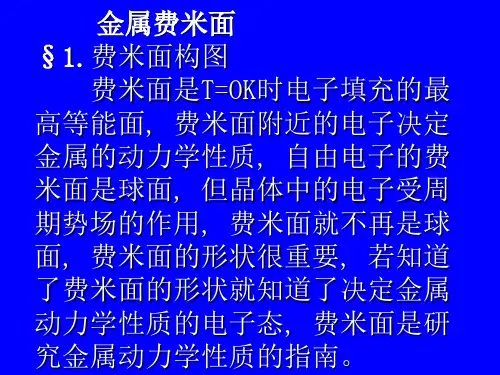
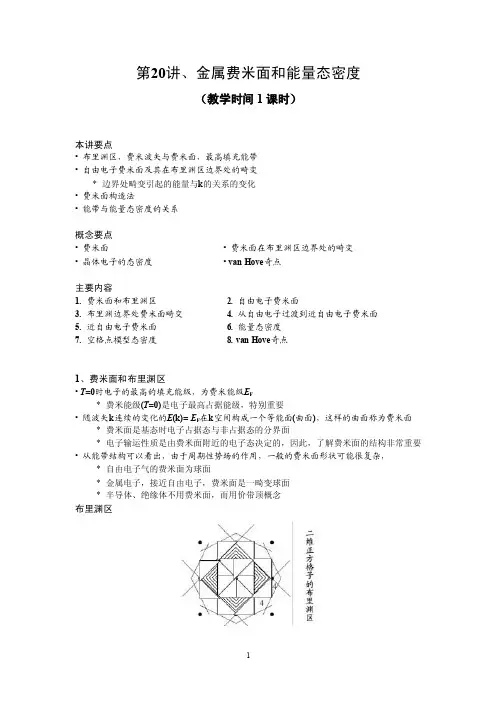
第20讲、金属费米面和能量态密度(教学时间1课时)本讲要点• 布里渊区,费米波矢与费米面,最高填充能带• 自由电子费米面及其在布里渊区边界处的畸变* 边界处畸变引起的能量与k的关系的变化• 费米面构造法• 能带与能量态密度的关系概念要点• 费米面• 费米面在布里渊区边界处的畸变• 晶体电子的态密度• van Hove奇点主要内容1. 费米面和布里渊区2. 自由电子费米面3. 布里渊边界处费米面畸变4. 从自由电子过渡到近自由电子费米面5. 近自由电子费米面6. 能量态密度7. 空格点模型态密度8. van Hove奇点1、费米面和布里渊区• T=0时电子的最高的填充能级,为费米能级E F* 费米能级(T=0)是电子最高占据能级,特别重要• 随波矢k连续的变化的E(k)= E F在k空间构成一个等能面(曲面),这样的曲面称为费米面* 费米面是基态时电子占据态与非占据态的分界面* 电子输运性质是由费米面附近的电子态决定的,因此,了解费米面的结构非常重要• 从能带结构可以看出,由于周期性势场的作用,一般的费米面形状可能很复杂,* 自由电子气的费米面为球面* 金属电子,接近自由电子,费米面是一畸变球面* 半导体、绝缘体不用费米面,而用价带顶概念布里渊区2、自由电子费米面• 根据价电子数N决定费米圆的半径• 导电电子面密度N/A• 费米球半径,四价金属四价金属• 以费米波矢k F为半径作圆,• 与第二、三、四布里渊区相交• 第一能带,全部占满• 第二、三、四能带部分• 围绕着邻近的倒格点作半径为k F的圆,可以看出每个B区的碎片形状• 前面是费米面的广延图,第一布里渊区已被占满,第二、三、四布里渊区被部分占满• 通常在简约布里渊区作费米面• 移动各个分片,即第二、三、四布里渊的分片到第一布里渊区,按不同能带作费米面3、布里渊边界处费米面畸变?• 边界处由于畸变引起的能量与k的关系变化* 对第一能带,同样的能量,近自由电子的k比自由电子的大* 对第二能带正好相反* 靠近边界时,等能面向外凸* 离开边界是,等能面向内缩• 因此,等能面在布里渊区边界是不连续的,不能连续穿越布里渊区边界• 而且,等能面与布里渊区边界垂直相交,看布里渊区边界面(k=K/2,k=-K/2)处的斜率• 所以费米面与布里渊区边界垂直相交等能面过布里渊区边界• P和Q是倒格点,* K是倒格矢* 垂直于K的直线即B区边界• 等能面S(实线)与边界相交* S’是其等价等能面,周期性* 现不连续过界• S不能连续地通过边界* 修正,圆弧* 圆弧与边界垂直相交• 等能面在B区边界发生突变Bragg反射面上的费米球• 二维正方格子一、二、三和四价金属的费米面• 先作自由电子费米面,靠近边界处有畸变• 下图(上)自由电子;下图(下)近自由电子费米面的畸变• 过渡到近自由电子近似,费米面在靠近布里渊区边界发生畸变:①. 等能面在远离布里渊区边界处,与自由电子相近,也是圆②. 等能面靠近布里渊区边界时,电子能量随波数k的增加比自由电子慢,因此,等能线偏离圆而向外凸出③. 等能面离开布里渊区边界时,电子能量随波数k的增加比自由电子快,因此,等能线偏离圆而向内收缩4、从自由电子过渡到近自由电子费米面• 自由电子,费米球• 靠近边界处,费米面有畸变• 费米面与布里渊区边界垂直相交• 费米面上的尖角钝化• 费米面所包围的总体积仅仅依赖于电子浓度,而不依赖于点阵相互作用细节步骤(Harrison方法)• 倒格子——画布里渊区• 自由电子:画半径与电子浓度有关的球• 将处在第二、三、…布里渊区的费米面碎片分别移到第一布里渊区• 变形费米面,使满足①. 与布里渊区边界垂直相交;②. 尖角钝化;③. 费米面包围的总体积不变等能面:二维正方格子等能面5、近自由电子费米面• 简约图:将高布里渊区的费米面移到简约布里渊区表示• 扩展图自由电子(fcc空晶格模型)费米面(略)自由电子(bcc空晶格模型)费米面(略)自由电子(hcp空晶格模型)费米面(略)金属费米面(略)6、能量态密度• 孤立原子中,能级分裂,每个能级能填两个不同状态的电子;• 而晶体中,能级准连续分布形成能带(能级间隔10-21eV)。
